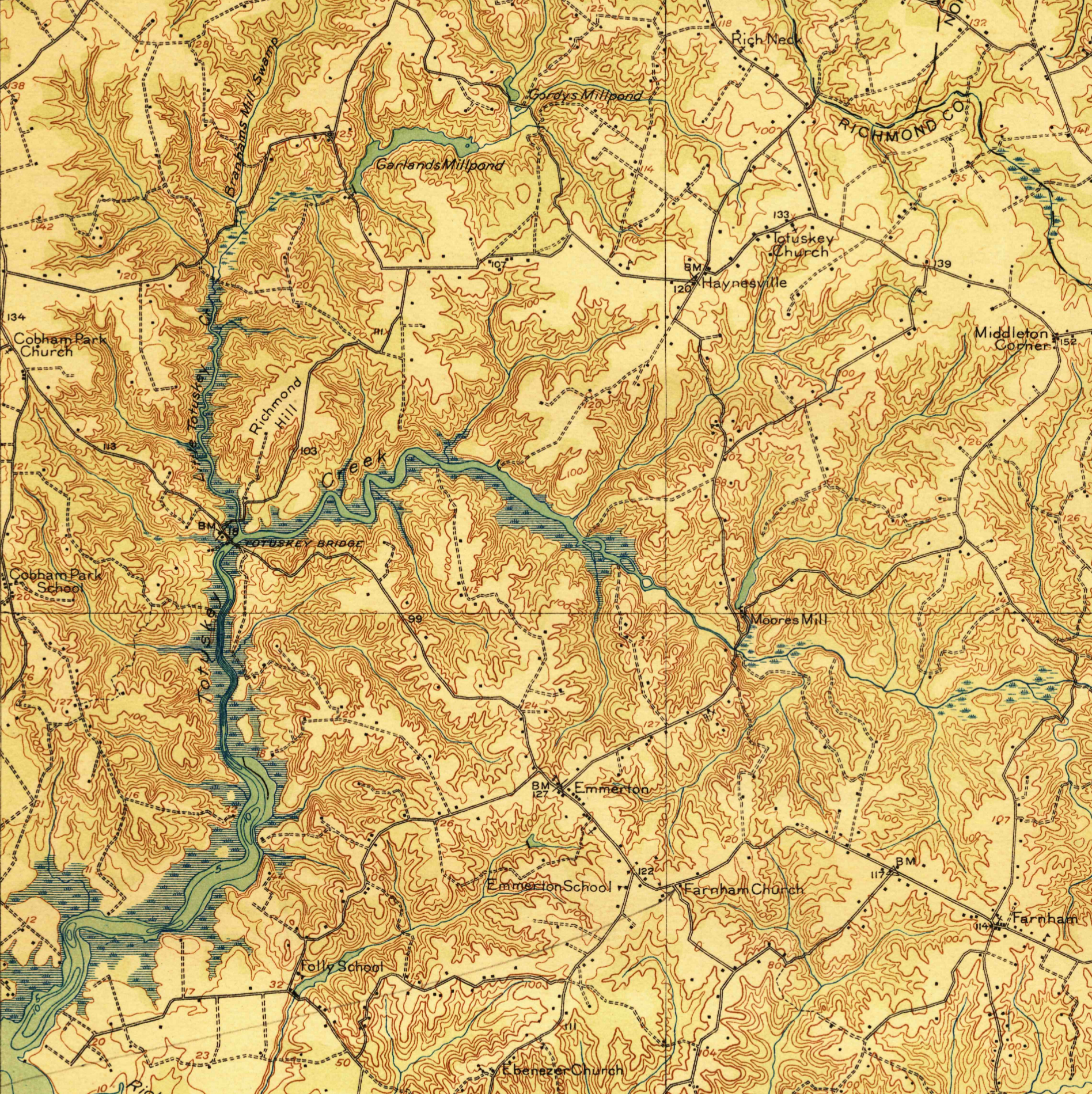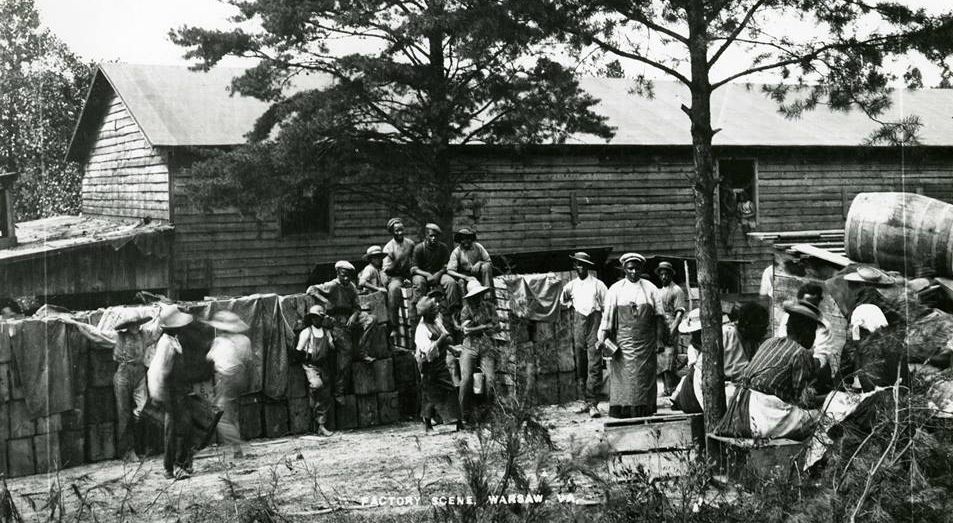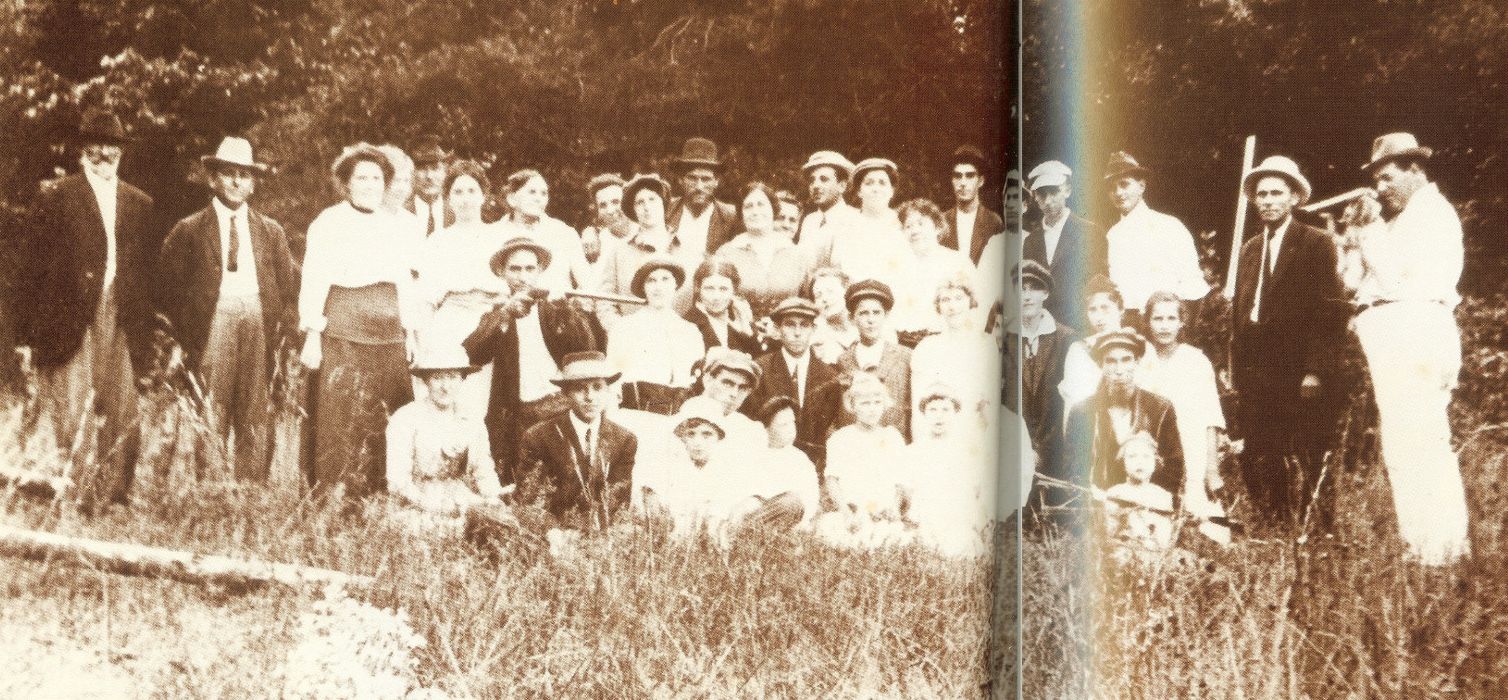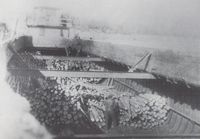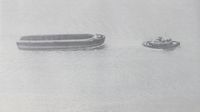Totuskey Creek
Totuskey Creek is a marshy body of water in Richmond County that flows into the Rappahannock River a mile east of Sharps. It's tributaries stretch all the way to the county's eastern boundary at Rainswood. The creek is said to be named for a Native American chief that once ruled the area and lived at Indian Town Swamp (also known as Totuskey Indian Town). The Village of Haynesville lies between the main branch of Totuskey Creek and the smaller Little Totuskey Creek branch to the west. Haynesville was known as Whirlabum before William Haynes opened a post office there. The portion of Totuskey Creek above the confluence with Little Totuskey Creek has been called Cross Creek because the Chicacone Indian Trail crossed from the Potomac to the Rappahannock by following the creek much of the way. Drinking Swamp is another marshy creek that feeds into the main branch of Totuskey Creek from the east. That creek may have been named as it became a watering spot for timber men to refresh their oxen on the way to Totuskey Mill.
A tobacco shipping warehouse stood on Totuskey Creek early in the colonial era. In 1778 Robert Carter III, the grandson of "King Carter," was baptized in Totuskey Creek by the Baptist minister Lewis Lunsford. After the decline of tobacco growing in Virginia the inlet remained a valuable transportation route for local farmers and timber men. Totuskey Creek reached far inland towards Haynesville and many small landings and saw mills scattered its shores. In the 1840s the Richmond Enquirer carried several advertisements for land along Totuskey Creek that touted the good timber business. Produce and wood products were transported down the creek to the Totuskey Bridge Store that stood near where present day Route 3 crosses Totuskey Creek. Larger vessels brought cargo like coal to Totuskey Bridge and left loaded with pulp wood and lumber. Advertisements from 1856 and 1880 both mention the granaries at the site of the store.
When the area was still part of Lancaster County in 1689 records show that a privately owned ferry operated across Totuskey Creek. Richmond County formed in 1692 and the county began running the ferry the following year. The first known bridge was built in 1742. Keeping a bridge in working order over Totuskey Creek was a constant struggle. The crossing was about 200 feet and early on any bridge material would have been wooden timbers. In 1849 an advertisement appeared seeking bids to re-build the Totuskey Bridge. In 1881 a broken span on the bridge was repaired at a cost of $75. In September of 1882 heavy rains flooded Totuskey Creek and the bridge was swept away. A ferry service operated in place of a bridge until June of 1883 when the new bridge opened at a cost of $1,200. The bridge was replaced again in 1908 for $950. In 1915 the bridge was closed for some time to make repairs.
Another struggle was maintaining a channel on the creek. In 1881 the Northern Neck News celebrated $5,000 in federal aid to dredge Totuskey Creek and said, "We hope the time is not far distant when we shall have a steamer running regularly to Totuskey Bridge, which is three miles of this place, and then Warsaw will be a city." It does not appear that regular steamboat service ever became a reality for Totuskey Creek and the wharf remained primarily a commercial hub for raw materials. Later that year the US Treasury Department estimated it would cost $17,000 to dredge the creek. Some dredging work was carried out in 1883. In 1907 the US Army Corps of Engineers declined to remove a sandbar in the creek. In 1909 representatives from the Crops returned to survey the site and consider future work. In 1928 legislation was again introduced asking for a study to create a 9 foot channel from Totuskey Bridge to the river.
In 1907 a Post Office named Totuskey was established at the intersection of Routes 607 & 617 (Canal & Normans Corner Roads). It was discontinued after only one year of service. In 1919 the Totuskey Post Office was reopened at William H. Sandy's store and operated until 1942. This Post Office was prosperous for at time partially due to the Postal Freight Service the ran from Reedville to Washington DC via Fredericksburg. Northern Neck residents could send eggs, butter and potatoes to the northern markets at a better rate than the steamboats offered. Local farmers were promised 70 cents a bushel for yellow potatoes and 75 cents for Irish potatoes. The Northern Neck News claimed that the freight route would be a great convenience to local business in the winters when Totuskey Creek froze up and supplies were hard to send in or out.
When the post office reopened a telephone was installed at W.H. Sandy's store and the community was connected to the whole world. The bigger change came in 1927 though when the Downing Bridge opened to connect Warsaw and Tappahannock. That same year bus lines from Richmond City began operating in the Northern Neck. A line was created from Irvington to Totuskey where passengers would then transfer to the main line to Richmond.
The increased car traffic coming into the Northern Neck called for improvements to the local roads and bridges. In early 1930 work was begun on a new steel bridge over Totuskey Creek, it cost just under $30,000. In late October the bridge was finished. Paving crews moved in to tar the approaches to the new bridge and it was said that Totuskey was the last link to create a paved road all the way from White Stone to Richmond.
With the new road network in place the Steamboat era on the Northern Neck came to a close and commercial shipping on Totuskey Creek ended. The creek remained a source of fish and game and it was said the during and after Prohibition a great many stills operated in the marshy swamps around Totuskey.
Map:

Newspaper Clippings:

- 1841 Totuskey Creek Farm for sale
- 1843 Totuskey Creek Farm for sale
- 1844 Totuskey Creek Farm for sale
- 1849 Bids accepted to rebuild Totuskey Bridge
- 1854 Petition to build a wharf on Totuskey Creek
- 1856 Totuskey Bridge Store for sale
- 1871 Drowning at Totuskey Creek
- 1878 General Assembly Bill to regulate use of Totuskey Wharf
- 1879 Wheat loading at Totuskey Bridge
- 1880 Totuskey Bridge Store for sale
- 1880 Congressman Beale Apporpriations for Totuskey
- 1881 US Government Funding for Totuskey Creek
- 1881 Funding to dredge Totuskey Creek
- 1881 Advertisment from Totuskey Bridge Store
- 1881 Bridge Repairs
- 1881 Bridge Repairs
- 1881 Estimate to dredge Totuskey Creek
- 1882 Captured Crows
- 1882 Totuskey Bridge destroyed
- 1882 New boat on Totuskey Creek
- 1882 Ferry service on Totuskey Creek
- 1882 Bids accepted for new Totuskey Bridge
- 1883 Dredging Machine
- 1883 New bridge nearing completion
- 1883 Sale of Totuskey Creek ferry boat and rope
- 1883 Richmond County expense for new bridge
- 1883 Large crane killed at Totuskey Creek
- 1886 Good road from Warsaw to Totuskey Bridge
- 1887 Coal shipment at Totuskey Bridge Store
- 1889 Native American artifact found at Totuskey Creek
- 1892 Totuskey Bridge Store advertisement
- 1893 Horse falls through Totuskey Bridge wharf
- 1893 Hawk and snake captured and killed
- 1900 Cord wood loaded at Totuskey Creek
- 1900 Smallpox at Totuskey
- 1906 Shooting at Totuskey Bridge
- 1907 Lumber shipment from Totuskey Creek
- 1907 Post Office established at Totuskey
- 1907 Corps of Engineers declines to remove sandbar in Totuskey Creek
- 1908 Pulp wood shipment from Totuskey Creek
- 1908 Totuskey Post Office discontinued
- 1908 New bridges built on Totuskey Creek
- 1909 Corp of Engineers Meeting at Totuskey Creek
- 1909 Murder at Emmerton
- 1911 Ships loading at Totuskey Creek
- 1911 Plentiful sora
- 1911 Sora hunting
- 1912 Tomato canning at Totuskey Bridge
- 1913 Poor road conditions around Totuskey Creek
- 1913 Totuskey Bridge Store Advertisement
- 1913 Good turkey hunting north of Totuskey Creek
- 1914 Henrico Lumber Company operating at Totuskey Creek
- 1914 Nor'easter floods Totuskey Creek
- 1915 Totuskey Bridge under repair
- 1919 New Post Office at Middleton's Corner
- 1919 The Floating Theater visits Totuskey Bridge
- 1919 New Post Office begins service
- 1919 Postal Freight Service
- 1919 Busy Postal Business
- 1919 Telephone installed at Totuskey
- 1919 Telephone installed at Totuskey
- 1920 Boat fire at Totuskey Creek
- 1920 Plentiful catfish in Totuskey Creek
- 1927 Richmond City bus line add stop at Totuskey
- 1927 Highway Robbery at Totuskey Bridge
- 1928 Federal survey for Totuskey Creek channel improvements
- 1929 Dump truck accident at Totuskey Creek
- 1930 Bids accepted for new Totuskey Bridge
- 1930 Road Paving at Totuskey Creek
- 1930 Truck breaks through Totuskey Bridge
- 1930 New Totuskey Bridge nearly complete
- 1930 Paving at Totuskey Bridge
Comments:

Sources:

- The Richmond Enquirer
- The Free Lance
- The Daily Dispatch
- The Virginia Citizen
- The Times Dispatch
- The Northern Neck News
- The Rappahannock Record
- A Pictorial History of the Northern Neck, John C. Wilson
- Richmond County Virginia 1692-1992 A Tricentennial Portrait, Robert R. Harper
Future 3:

Future 4:

Future 3:



